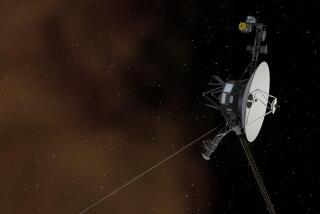Study refuels debate over whether Voyager 1 has left solar system
- Share via
Voyager 1, where are you?
After traveling more than 11 billion miles, there’s no doubt the 36-year-old spacecraft is the farthest man-made object from Earth. But whether the probe has exited the solar system and is now speeding through interstellar space has become a contentious issue among scientists.
NASA insists Voyager remains within the heliosphere, the bubble of magnetism that emanates from the sun and stretches far beyond the orbits of Neptune and Pluto. In fact, Voyager scientists say the craft is now traveling through a mysterious region at the very edge of the heliosphere.
But not everyone is convinced. A study published Thursday in the Astrophysical Journal Letters argues that Voyager 1 actually exited the heliosphere more than a year ago and is “truly beginning its travels through the Milky Way.”
After running 100,000 processor hours of computer simulations on a Berkeley supercomputer called Hopper, the study authors concluded that NASA scientists misinterpreted magnetic field data collected by Voyager. As a result, they missed the probe’s big exit.
“It’s a somewhat controversial view,” said Marc Swisdak, an astrophysics researcher at the University of Maryland and lead author of the study.
NASA scientists have said for years that they’ll know Voyager has left the solar system when the local magnetic field changes. Beyond the heliosphere, magnetic fields emanate from the long arms of our galaxy, and not the sun; Voyager should be able to detect this.
Swisdak and his colleagues, however, make the case that NASA failed to account for a phenomenon called magnetic reconnection. That’s when opposing magnetic field lines come together, snap and form new connections. Reconnection is believed to be responsible for the sun’s explosive solar flares and coronal ejections.
The study authors hypothesize that the magnetic fields of the sun and of interstellar space have joined together in areas they call “magnetic islands,” and that these islands make the border of the heliosphere very uneven. To add to the confusion, these combined magnetic fields run in the same direction.
In other words, NASA scientists have been waiting for the wrong signal, they argue.
The researchers say Voyager crossed the envelope of the heliosphere on July 27, 2012. That’s the day Voyager recorded a permanent drop in heliosphere-produced particles and an increase in galactic cosmic rays from outside the solar system.
According to Swisdak, Voyager will eventually detect a change in the magnetic field, but it will occur gradually as Voyager moves farther away from the heliosphere. Only then, when it is clear of the border area distortion, will the probe be able to measure the interstellar magnetic field in an undisturbed state, he said.
Some of the confusion stemmed from the fact that scientists expected that the magnetic fields would change at the same time that particles from the sun abated and galactic rays increased, Swisdak said. “Our paper argues that this isn’t the case,” he said.
This isn’t the first time scientists have argued that Voyager 1 has left the solar system. In March, a Voyager scientist broke ranks and published a paper in the American Geophysical Union that suggested the probe had exited the heliosphere on Aug. 25, 2012, when it began to register drastic changes in radiation levels.
That claim was soundly dismissed by Voyager project scientist Ed Stone and other team members, who insisted once again that a measured change in magnetic fields would herald the spacecraft’s departure.
“We did not leave the solar system,” Boston University astrophysicist Merav Opher, a member of Voyager’s scientific team, said at the time.
But Stone was open to the study published Thursday, and NASA issued a statement saying it would consider the arguments while interpreting Voyager data.
“The Voyager 1 spacecraft is exploring a region no spacecraft has ever been to before,” said Stone, a professor at Caltech in Pasadena. “We will continue to look for any further developments over the coming months and years as Voyager explores an uncharted frontier.”
Opher has changed her tone too — she is one of the authors of the new study.







